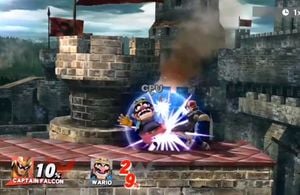Frame canceling: Difference between revisions
(Info on landing hitboxes) |
m (Removed comma) |
||
| (20 intermediate revisions by 16 users not shown) | |||
| Line 1: | Line 1: | ||
{{ArticleIcons|ssb4=y}} | {{ArticleIcons|ssb4=y}} | ||
'''Frame | [[image:frame_cancel.jpg|300px|thumb|{{SSB4|Captain Falcon}} frame cancelling a forward aerial on {{SSB4|Wario}}]] | ||
'''Frame canceling''' or frame syncing is an advanced technique in ''[[Super Smash Bros. 4]]'' that reduces the [[landing lag]] of aerial attacks. The technique involves timing an aerial so that it hits the non-shielding opponent on the same frame that the user would land on the ground. This results in a bug where the attack's landing lag starts counting down during the [[freeze frame]]s of the hit, resulting in there being less lag once the freeze frames end and both characters begin moving again. | |||
Attacks that deliver high amounts of freeze frames get more usefulness out of the technique. The down aerials of {{SSB4|Falco}} and {{SSB4|Ganondorf}} are most notable for this, with the former having a 2.0x freeze frames multiplier, and the latter dealing high [[electric]] damage. Due | Attacks that deliver high amounts of freeze frames get more usefulness out of the technique. The down aerials of {{SSB4|Falco}} and {{SSB4|Ganondorf}} are most notable for this, with the former having a 2.0x freeze frames multiplier, and the latter dealing high [[electric]] damage. The sweetspot of {{SSB4|Cloud}}'s forward aerial can also be frame cancelled this way. Due to the very strict timing needed to pull it off consistently, frame cancelling is almost never used in that way in competitive matches. | ||
It is not to be confused with hitting an opponent with a landing hitbox of an aerial, though a similar effect is achieved. | |||
==See also== | |||
*[[L-canceling]] | |||
*[[Jump-canceling]] | |||
*[[Drop cancel]] | |||
[ | ==External links== | ||
[[Category:Techniques (SSB4 | *[http://smashboards.com/threads/frame-syncing.434603/ Smashboards thread with more detailed explanation of the phenomenon] | ||
[[Category:Glitches]] | |||
[[Category:Techniques (SSB4)]] | |||
[[Category:Glitches (SSB4)]] | |||
Latest revision as of 19:03, September 16, 2020
Frame canceling or frame syncing is an advanced technique in Super Smash Bros. 4 that reduces the landing lag of aerial attacks. The technique involves timing an aerial so that it hits the non-shielding opponent on the same frame that the user would land on the ground. This results in a bug where the attack's landing lag starts counting down during the freeze frames of the hit, resulting in there being less lag once the freeze frames end and both characters begin moving again.
Attacks that deliver high amounts of freeze frames get more usefulness out of the technique. The down aerials of Falco and Ganondorf are most notable for this, with the former having a 2.0x freeze frames multiplier, and the latter dealing high electric damage. The sweetspot of Cloud's forward aerial can also be frame cancelled this way. Due to the very strict timing needed to pull it off consistently, frame cancelling is almost never used in that way in competitive matches.
It is not to be confused with hitting an opponent with a landing hitbox of an aerial, though a similar effect is achieved.
